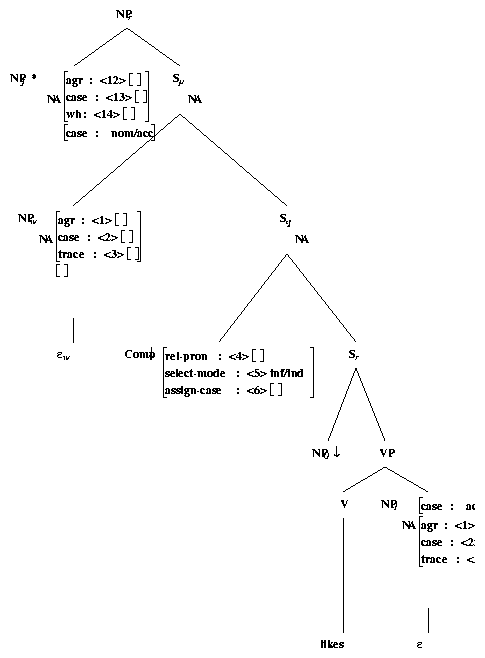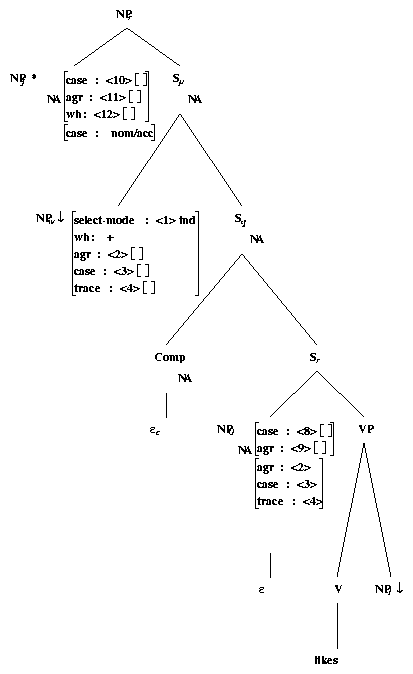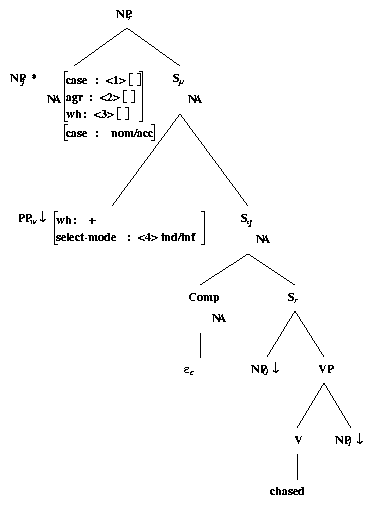

Relative clauses are represented in the English XTAG grammar by auxiliary trees
that adjoin to NP's. These trees are anchored by the verb in the clause and
appear in the appropriate tree families for the various verb
subcategorizations. Within a tree family there will be groups of relative
clause trees based on the declarative tree and each passive tree. Within each
of these groups, there is a separate relative clause tree corresponding to each
possible argument that can be extracted from the clause. There is
no relationship between the extracted position and the head NP.
The relationship between the relative clause and the head NP is treated
as a semantic relationship which will be provided by any reasonable
compositional theory. The relationship between the extracted element
(which can be covert) is captured by co-indexing the <trace> features of the extracted NP and the NPw node in the
relative clause tree. If for example, it is NP0 that is extracted,
we have the following feature equations:
NPw.t: trace NP0.t: trace
NPw.t: case NP0.t: case
NPw.t: agr NP0.t: agr
15.1
Representative examples from the transitive tree family
are shown with a relevant subset of their features in
Figures 15.1(a) and 15.1(b).
Figure 15.1(a) involves a relative clause with a
covert extracted element, while figure 15.1(b)
involves a relative clause with an overt wh-phrase.15.2
 |
 |
| (a) | (b) |
The above analysis is essentially identical to the GB analysis of relative clauses. One aspect of its implementation is that an covert +<wh> NP and a covert Comp have to be introduced. See ((211)) and ((212)) for example.
The lexicalized nature of XTAG makes it problematic to have trees headed by null strings. Of the two null trees, NPw and Comp, that we could postulate, the former is definitely more undesirable because it would lead to massive overgeneration, as can be seen in ((213)) and ((214)).
The presence of an initial headed by a null Comp does not lead to problems of overgeneration because relative clauses are the only environment with a Comp substitution node. 15.3 Consequently. our treatment of relative clauses has different trees to handle relative clauses with an overt extracted wh-NP and relative clauses with a covert extracted wh-NP. Relative clauses with an overt extracted wh-NP involve substitution of a +<wh> NP into the NPw node 15.4 and have a Comp node headed by C built in. Relative clauses with a covert extracted wh-NP have a NPw node headed by w built in and involve substitution into the Comp node. The Comp node that is introduced by substitution can be the C (null complementizer), that, and for. For example, the tree shown in Figure 15.1(b) is used for the relative clauses shown in sentences ((215))-((216)), while the tree shown in Figure 15.1(a) is used for the relative clauses in sentences ((217))-((220)).
Cases of PP pied-piping (cf. (221)) are handled in a similar fashion by building in a PPw node.
See the tree in Figure 15.2.
 |